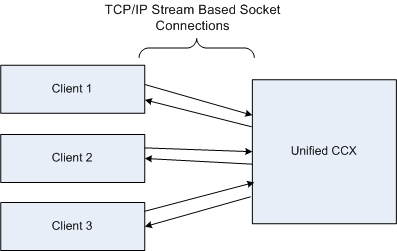Unified CCX CTI Client/Server Architecture
Figure 1 shows the general architecture of a Unified CCX CTI client/server system. It shows one or more CTI clients exchanging information with a Unified CCX system. Each client is its own separate program. CTI protocol messages are transported on top of TCP/IP protocol. They are stored in the data section of TCP/IP packets.
The Unified CCX CTI system listens on a configurable TCP/IP port for socket connections from CTI clients. After a TCP/IP connection is established between the Unified CCX and a CTI client, hand-shake messages are exchanged between the Unified CCX and the CTI client. If the handshake is successful, a session is opened. When the session is successfully opened between the CTI client and Unified CCX, the client may begin using the full set of Unified CCX CTI features. This is the subject of the rest of this guide.

All Unified CCX CTI messages are received and sent through the CTI server module of the RMCM (Resource Manager- Contact Manager) Subsystem, used for resource distribution and the queuing of calls to call centers. See the Cisco Unified Contact Center Express Administration GuideCisco Unified Contact Center Express Administration and Operations Guide for more information on this.